
* The idea of using an aircraft to launch another aircraft has been around since at least the First World War. Such "composite" aircraft became nothing particularly unusual, with experimental aircraft like the Bell X-1 and drones being launched off carrier aircraft platforms on a routine basis. However, the notion of actually launching and then recovering an aircraft in mid-air -- for example, a heavy bomber carrying its own "parasite" fighters for escort -- was more ambitious, and in fact nobody's ever really made a go of it, if not for lack of effort. This document provides a history of the parasite fighter concept.
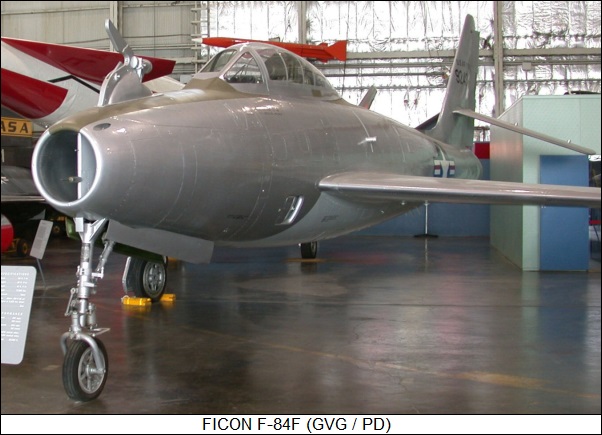
* The notion of an aircraft carrying another aircraft very likely goes back to the beginning of powered flight, but as far as the records show the first serious experiments with the concept were at the end of the First World War. In 1918, the British dirigible (rigid airship) R23r carried a series of Sopwith Camel fighters aloft and launched them in mid-air -- though they weren't recovered by the airship.
The first launch and recovery of an aircraft in mid-air appears to have been by the US Army TC-3 blimp (nonrigid airship) on 15 December 1924, with a Sperry Messenger biplane performing a sortie from and back to a "skyhook" attached to the blimp. The British dirigible R33 was next to perform an aerial recovery, first of a DH 53 Hummingbird in 1925 and then Gloster Grebe fighters in 1926. However, the most famous of the prewar parasite fighter carriers were the US Navy airships AKRON and MACON.
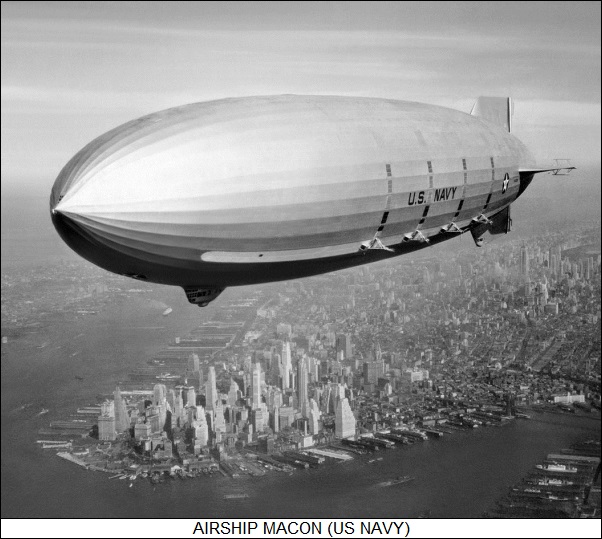
From the mid-1920s, the US Navy had been working on next-generation dirigibles, and decided that the new airships would have parasite aircraft capability. A launch and recovery trapeze system was evaluated in flight tests on the existing dirigible LOS ANGELES, an ex-German machine, in 1929, though the LOS ANGELES had no facilities for handling an aircraft once it had been recovered.
The new Navy dirigible ZRS-4 / AKRON, which was christened on 8 August 1931, was designed as a parasite aircraft carrier. The AKRON was a huge machine, 239 meters (785 feet) long, only slightly shorter than the great German Zeppelin HINDENBURG. The AKRON was powered by eight engines, mounted inside the airship hull to power the propellers through a driveshaft arrangement, and had an internal hangar for up to five parasite aircraft. The hangar was roughly 22.9 meters long, 18.3 meters wide, and 4.9 high (75 x 60 x 16 feet) and had a tee-shaped opening at the front, through which an extensible trapeze system could launch and recover aircraft.
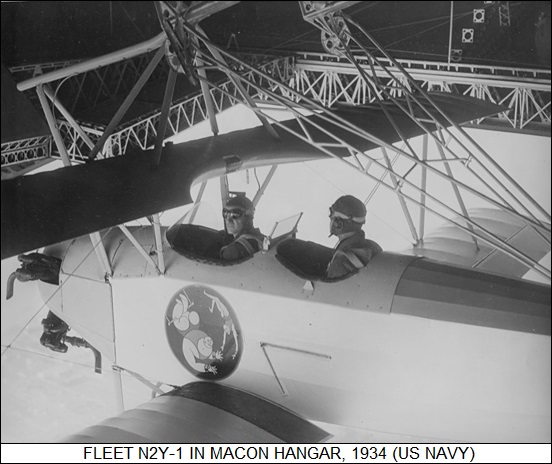
The AKRON operated Fleet N2Y-1 trainers and Curtiss F9C-2 Sparrowhawk fighters, both being biplanes fitted with a fixed "skyhook" on the top wing to snag the AKRON's trapeze. The N2Y-1 trainers were modifications of stock machines, while the F9C-2 machines were new build, derived from the F9C-1 carrier fighter. The F9C-2 featured some improvements relative to the F9C-1, such as a more powerful engine and cleaner landing gear arrangement, as well as a modified upper wing to give the pilot a better field of view for dockings with the trapeze. A bigger rudder was added later after turbulence was found to be a problem in dockings; experiments were also conducted with Sparrowhawks that had their landing gear removed, with these machines having the capability to carry a belly fuel tank with a capacity of 114 liters (30 US gallons).
* On the night of 3 April 1933, the AKRON went down in the Atlantic in a storm off the coast of New Jersey, with most hands lost. However, its sister ship ZRS-5 MACON had been christened on 11 March 1933, so the Navy parasite aircraft experiments continued. The basis of the parasite scheme was that the dirigible would launch scout aircraft to range far from the "mother ship", but the N2Y-1 was really only useful as a utility aircraft and the F9C-2 was a fighter. More modern Waco ZJW-1s -- modifications of the Waco UBF three-seat sport plane -- were acquired to replace the elderly N2Y-1s, and design work was underway to develop a modern monoplane scout aircraft to be carried by the MACON. It all came to nothing when the MACON was lost in turn off the coast of California on 12 February 1935, this time with the majority of the crew surviving.
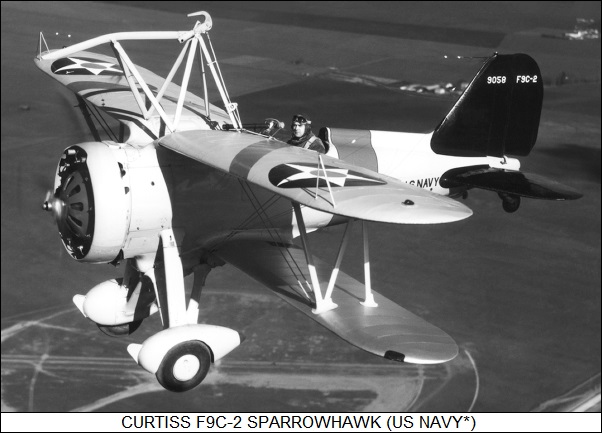
The Navy never built another dirigible, and the monoplane scout aircraft never flew. A few of the Sparrowhawks had been grounded when the MACON went down and survived, with one now on display at the Smithsonian. The Navy continued to toy with the idea of a flying aircraft carrier, with proposals including a monster dirigible 274 meters (900 feet) long that would carry nine to twelve aircraft tucked semi-conformally underneath its hull, instead of hauled into an internal hangar. It didn't happen. The Navy did make considerable use of blimps during World War II for coastal patrol, but the vision of dirigibles ranging far across the oceans to launch bombers and fighters on raids remained in the pages of science-fiction pulp magazines -- which was probably all for the best.
BACK_TO_TOP* The primary work on use of a fixed-wing aircraft as a flying aircraft carrier in the prewar period was conducted by a Soviet aeronautical engineer named Vladimir Sergeyevich Vakhmistrov, who was originally employed by the Scientific Research Institute of the Red Air Force ("NII-VVS" in its Russian acronym). He worked on various configurations of bombers carrying fighter aircraft under the "Zveno" project. The term "Zveno" does not translate easily; the best approximation is the term "flight", as in flight group of aircraft, the Zveno being such a group in itself.
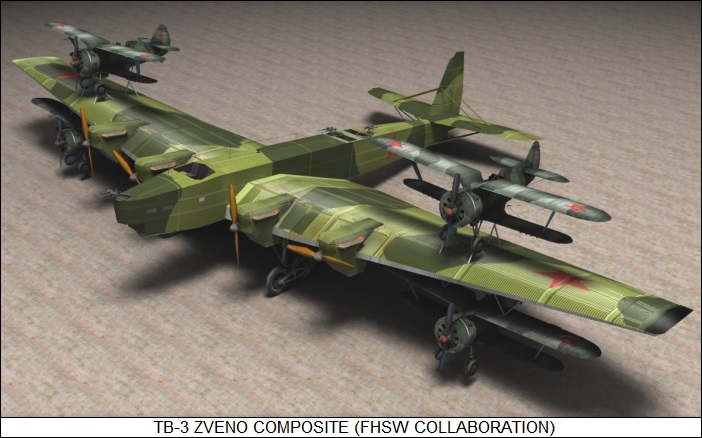
In the spring of 1931, Vakhmistrov proposed that flights of bombers might carry their own escort fighters. This was not the first time such a "composite" aircraft had been proposed, and in fact an aircraft had first launched another aircraft back in 1916. Vakhmistrov's notion was a slight refinement of this basic concept, with the parasite fighters remaining powered at all times and kept topped off with fuel from the bomber carrier aircraft. Keeping the propellers of the fighter running would permit, in principle, safe take-offs of the clumsy assembly. The carrier platform would not haul a bombload, instead being dedicated to providing fuel for the fighters. Once in the combat area, the fighters would be released to protect the bombers, and then fly back home under their own power. At the outset, Vakhmistrov did not envision midair recovery of the fighters, so his concept fell slightly short of being a true flying aircraft carrier.
The authorities liked Vakhmistrov's proposal and allowed him to set up a development team under the umbrella of the Central Aerodynamics & Hydrodynamics Research Institute ("TsAGI" in its Russian acronym). Vakhmistrov had nailed down most of the details before going forward with his proposal, and so the first "composite aircraft Zveno" was ready to fly by the fall. The "Zveno-1" was based on a Tupolev TB-1 twin-engine bomber used as the carrier platform, with a Tupolev I-4 fighter perched above each wing on strut assemblies known as "spiders". Loading up the I-4s proved a bit problematic due to the non-availability of cranes for the task, but wooden loading ramps were thrown together and did the job. The initial trial was on 3 December 1931; the flight went less than smoothly and featured some frightening complications, but the result was still judged successful.
Five "Zveno-1a" composites were built, using new Polikarpov I-5 biplane fighters instead of the Tupolev I-4. These composites were strictly for training, the objective being to create a composite with the carrier platform being a Tupolev TB-3 -- essentially a scaled-up, four-engine TB-1 -- capable of carrying five fighters, including two above the wings, two below the wings, and on the fuselage spine. The more fighters one bomber could carry, the fewer bombers would be required to haul escorts for a bomber formation.
However, the initial TB-3 combination, the "Zveno-2", only carried three I-5 fighters, dispensing with the underwing machines because more development was required to figure out how to handle them. Trials of the Zveno-2 were conducted in 1934 and 1935, with the results proving technically workable. It wasn't adopted for service, the range of the composite proving inadequate for supporting long-range bomber formations. Preparation for Zveno-2 flights were also impractically time-consuming; placing the fighter on the bomber's spine was particularly troublesome, so it was often simply loaded up and left there, never to be released.
* While working on the Zveno-2, Vakhmistrov was also performing trials with another TB-3-based composite designated the "Zveno-3" to experiment with underwing carriage. The problem with underwing carriage was that if the fighter was carried too low, its wheels would hit the ground on take-off, and if it had a high wing and was carried too high, airflow might well trap the fighter under the wing of the carrier platform on release.
The solution was judged to be a trapeze that would hold the fighter up close to the wing during take-off and cruise, then drop it well beneath the wing for release. The first test of the scheme in the summer of 1934 led to disaster, with the fighter caught up in flight under the wing of the bomber; on landing, the fighter was torn off the bomber's wing and tumbled, killing the pilot, Alexey Korotkov. This was the only fatal accident in the program, but it was a major blow to the effort, with Vakhmistrov discharged from the military and booted out of TsAGI.
The program was not canceled, however, with Vakhmistrov and his team taking up their work again in an office in a state factory, developing the next-generation "Zveno-5" composite, which was to test midair recovery techniques. Vakhmistrov had decided that midair recovery greatly enhanced the utility of the composite scheme, and in fact had patented a concept for a huge flying wing that could operate as a true flying aircraft carrier with a load of ten fighters. Midair recovery of an airplane by another airplane had never been accomplished before. American flying daredevil Lawrence Sperry, son of and collaborator with his father, the famous engineer Elmer Sperry, had tried it in 1923 and failed. Vakhmistrov decided to give Sperry's experiment another shot, attaching a skyhook above the nose of a Grigorivich I-Z monoplane fighter and a hinging trapeze to the belly of a Tupolev TB-3. With this setup, pilot Vasily Stepachenok flew the first midair recovery of an airplane by another airplane on 23 March 1935.
Vakhmistrov also continued to work on nonrecoverable Zveno configurations, most significantly the "Air Defense Aircraft Mother Plane", or "AMPVO" in its Russian acronym. Instead of long-range bomber escort, the AMPVO was intended for air defense, flying fighters to areas in need of protection. The AMPVO carried a Polikarpov I-15 biplane fighter above each wing, a Polikarpov I-16 monoplane fighter -- at the time the best fighter the Red Air Force had -- under each wing, and an I-Z fighter under the belly. It was demonstrated in November 1935 and observers were impressed with the feat, but few thought it much more than a gimmick, which would prove to be a sign of things to come.
* In parallel with these experiments, design work went forward on a dedicated parasite fighter, the Grigorivich "I-ZW", which looked much like the Polikarpov I-16. Like the I-16, the I-ZW was a barrel-shaped monoplane aircraft with a low-mounted wing; however, the I-ZW had clear differences, such as an "inverted gull" wing and the cockpit moved farther back. The I-ZW had a retractable skyhook system on top of the forward fuselage but lacked landing gear, with the "kink" in the inverted gull wing reinforced to operate as a landing skid; provisions were made to lock the two-bladed propeller in the horizontal position for landings. The lack of landing gear permitted more armament, ammunition, and fuel.
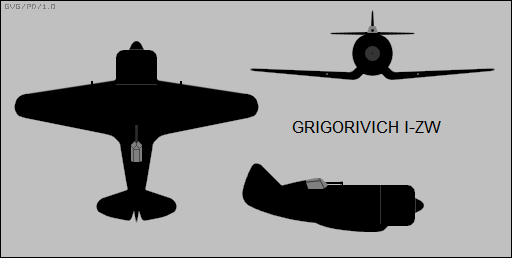
The I-ZW never reached flight status. When Soviet dictator Josef Stalin was told about the I-ZW project in early 1937, he dismissed the idea as a "fantasy". That was the end of the I-ZW, though work continued on the Zveno concept, resulting in the "Z-7" -- a TB-3 capable of recovering an I-16 under each wing. Test flights were performed in 1938 and 1939, with parasite fighter pilots initially encountering difficulties with midair dockings, sometimes damaging the docking gear.
* Vakhmistrov, always eager to promote his Zveno concept, had another scheme going in parallel, in which I-16s were rigged up to carry a FAB-250 250-kilogram (550-pound) bomb under each wing to operate in the role of "Fast Dive Bomber" -- "SPB" in its Russian acronym -- resulting in the "I-16SPB". That was a hefty bombload for the fighter to get off the ground with, but no worries: two I-16SPBs could be carried aloft by a TB-3, one under each wing, and then hauled to a target area. It was a slick concept: the TB-3 was getting too old and helpless to penetrate to a defended target, but it could haul a pair of I-16SPBs over much longer range than the fighters could handle on their own to perform the attacks. This new composite was designated the "Z-SPB".
Midair recovery was not contemplated, since the fighters would be released close to the target and, having dropped their loads after a short flight, would have adequate range to make it back home on their own; maximum operational radius of the system was estimated at 400 kilometers (250 miles). However, even given the past Zveno experience, the development of the Z-SPB was not trivial, since the bombed-up I-16SPBs were heavier than any other aircraft load carried by a Zveno to that time. The wings of the I-16SPBs had to be reinforced to handle the bombs, while the TB-3's suspension system had to be reinforced as well.
In response to Red Navy interest, some work was performed on modification of an I-16 to carry a single BRAB-500 500-kilogram (1,100-pound) armor-piercing bomb on the centerline, using a swing-out yoke to allow the bomb to clear the propeller in a dive attack -- the BRAB-500 being potentially very useful for attacks on heavily-armored warships. This scheme didn't get to the flight-test stage, and a similar idea for an I-16 to carry a torpedo on the centerline never went beyond casual investigation. Vakhmistrov also pushed ideas for a TB-3 carrying four I-16s, either for air defense or the attack role, but that didn't happen either.
Initial flight of the Z-SPB was in July 1937, and though trials moved in fits and starts, they went well enough to authorize service adoption of the Z-SPB by the Red Air Force and the Red Navy's air arm in early 1939. However, the Z-SPB was seen as an orphan child by the Red Air Force, which finally abandoned the concept in June 1940, with production canceled. Fortunately for Vakhmistrov, the Red Navy was more enthusiastic -- though only a handful of Z-SPB composites, using somewhat weary TB-3s, ended up being available for service.
After the Nazi invasion of the USSR on 22 June 1941, the Z-SPBs actually saw significant combat use, being sent to the Black Sea region for operations. The first Z-SPB raid was conducted on an oil depot in Constanta, Rumania on 26 July 1941. Two I-16SPBs were released on the raid, which was highly successful, the Rumanian defenders having no warning. In fact, the I-16SPBs conducted a casual circle over the town before diving in, with no one on the ground paying them real attention until the bombs went off. Further Z-SPB attacks were conducted, with a particular focus on bridges, which the I-16SPBs proved effective in bringing down; the average ratio of bomb hits to misses in Z-SPB missions easily exceeded 50% -- not bad for the era of unguided munitions, a testimony to pilot skill at dive-bombing. Vakhmistrov provided engineering assistance to further Z-SPB operations, developing an external fuel tank to help stretch the range of the I-16SPB and beefing up the armor and defensive weapons of the vulnerable TB-3s.
Records of what the Rumanians and Germans thought of the Z-SPB attacks are sketchy, but it appears they were baffled as to where the little Polikarpov fighters were coming from. German advances in the south finally forced the withdrawal of the Z-SPBs, the last combat operation taking place on 22 October 1941. They did not see action again, since both the I-16 and the TB-3 were effectively obsolete. A total of 29 sorties of the Z-SPB took place, expending a total of 116 bombs, with losses of three I-16SPBs but no TB-3s.
* Vakhmistrov churned out other composite concepts through the war, such as:
None of these things happened; Vakhmistrov never fully achieved his dreams of flying aircraft carriers, and indeed all his work on composites never amounted to more than an interesting footnote of aviation history. After the conflict, Vakhmistrov remained in the aircraft industry, becoming a contributor to the development of Soviet inflight refueling. The Soviets did become very fond of large air-launched missiles in the postwar period, and modified or developed piloted jet aircraft as test and training missile "surrogates". Little information is available that hints they otherwise tinkered with parasite fighter concepts after World War II.
BACK_TO_TOP* However, the Americans proved very interested in the parasite fighter concept after the war. In 1944, the US Army Air Forces (USAAF) were working on development of the huge, intercontinental range B-36 bomber and were considering how it might be escorted to distant target areas. Any fighter with range comparable to that of the B-36 would be so big and heavy as to be almost useless as an air combat fighter. One option was to actually have the B-36 carry its escort along with it.
Trying to find an aviation firm willing to build such an aircraft turned out to be problematic -- apparently the idea seemed too far out and unlikely to result in production orders to justify the labor of prototype development, even with the military footing the bill. The McDonnell Aircraft Company of Saint Louis, Missouri, proved willing to take on the project; McDonnell had been getting by with subcontracting and license production, had never developed a production aircraft, and was willing to take the risk. The company submitted four concepts for the "McDonnell Model 27" parasite fighter to the USAAF.
There was some discussion of the configuration of the Model 27 for a time -- the brass originally wanted a fighter that could also be carried by the B-29 Superfortress, but finally decided that the fighter had to be fully stowed while being carried on the launch aircraft, restricting its use to the B-36. With the proper configuration established, McDonnell was awarded a contract in October 1945 for the "Model 27E", which was given the service designation of "XP-85", with a mockup and two flight prototypes to be built. The aircraft acquired the name "Goblin", an early example of the McDonnell custom of naming aircraft after supernatural creatures.
Development of the XP-85 was assigned to a team under Herman D. Barkey, a recent hire from Curtiss Aircraft -- who, incidentally, would be responsible for most of McDonnell's later jet fighter designs, up to the F-4 Phantom. Trying to define a fighter jet that could fit snugly into the bomb bay of a B-36 was of course a challenge, and the design that emerged was unusual by anyone's standards. It was a tiny, egg-shaped machine with a prominent bubble canopy, low-mounted swept wings, a trident-like triple tailfin arrangement, and triple fixed ventral fins -- though the mockup only had two tailfins and two ventral fins.
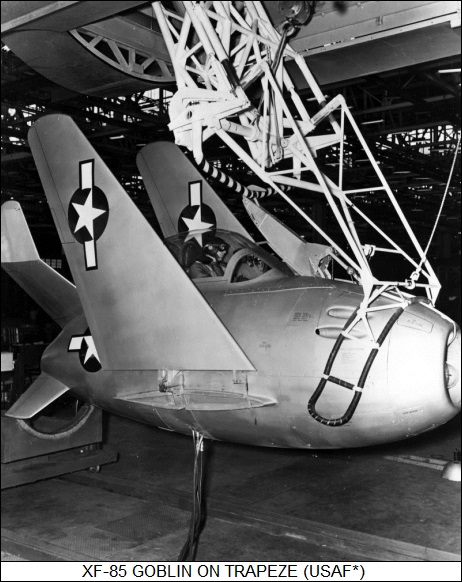
The Goblin was powered by a single Westinghouse J34-WE-22 axial-flow turbojet with all of 13.4 kN (1,360 kgp / 3,000 lbf) of thrust, and armament was to be four 12.7-millimeter (0.50-caliber) Browning machine guns, with 300 rounds per gun. There was a perforated air brake under the rear fuselage and a skyhook that pivoted up from a bay in the aircraft's nose to allow the fighter to snag a trapeze extended from a carrier platform; the wings hinged up hydraulically to permit loading into the carrier aircraft bomb bay. The cockpit was cramped and the instrument layout was minimal, but the pilot did have an ejection seat. The seat was canted back 33 degrees to reduce height.
The XP-85 had skid landing gear for emergency landings; after some tinkering, a single skid was mounted on the belly, along with a runner under each wingtip. A trolley cart was designed to allow the Goblin to be conveniently rolled around on the ground.
___________________________________________________________________
MCDONNELL XP-85 GOBLIN:
___________________________________________________________________
wingspan:
6.44 meters (21 feet 2 inches)
wing area:
8.36 sq_meters (90 sq_feet)
length:
4.53 meters (14 feet 10 inches)
height:
2.56 meters (8 feet 3 inches)
empty weight:
1,695 kilograms (3,740 pounds)
loaded weight:
2,064 kilograms (4,550 pounds)
max speed at altitude:
1,045 KPH (650 MPH / 565 KT)
service ceiling:
14,700 meters (48,200 feet)
endurance:
30 minutes
___________________________________________________________________
In the spring of 1946, the XP-85 mockup was tested along with a mockup of a B-36 bomb bay for fit and operation. The trapeze system was actually influenced by and noticeably similar to that used on the AKRON-MACON. Since the USAAF couldn't spare any B-36s at the time, flight tests of the Goblin were to be performed using a Boeing B-29B Superfortress bomber bailed to McDonnell -- designated "EB-29B" to indicate it as a special test machine. The EB-29B, nicknamed "Monstro", was fitted with the trapeze system and given a bright yellow rear fuselage plus other yellow markings to allow it to be easily spotted.
On 22 July 1947, before initial flights of the XP-85 began, USAAF Major Ken Chilstrom and McDonnell test pilot Robert Eldholm flew Lockheed P-80 jet fighters in simulated docking approaches to a B-29 Superfortress, with both pilots reporting no difficulties with the procedure. That fall, the first prototype XP-85 was airlifted by a Boeing C-97 Stratocruiser transport to the big wind tunnel at Moffett Field in the California Bay Area operated by Ames Aeronautical Lab -- the Ames lab being a facility of the US National Advisory Committee on Aeronautics (NACA, the main predecessor organization to the US National Aeronautics & Space Administration, NASA). The prototype was dropped by a crane, and had to be hauled back to Saint Louis for repairs; the second prototype did the wind tunnel test honors in its place.
By that time, the USAAF had become an independent service, the US Air Force (USAF). In the spring of 1948, the second prototype XP-85 was flown to Muroc Air Force Base (now Edwards AFB) in California for flight tests with the Monstro carrier aircraft. A special pit had to be constructed into which the Goblin could be lowered, allowing the EB-29B to roll over it for loading up. The initial "flight" of sorts of the XF-85 -- the Air Force had recently changed the "P" for "pursuit" designation to "F" for fighter -- was on 22 July 1948, with McDonnell test pilot Edwin Schoch, an ex-Navy fighter pilot, at the controls.
The Goblin was never actually released from the carrier platform during this flight, being simply lowered on the trapeze into the airstream, where Schoch fired up the engine and exercised the flight controls. Five more captive flights were performed before Schoch was actually released on 23 August 1948. Flight handling was generally good, but Schoch found himself in real trouble when he tried to mate back up with the trapeze under the EB-29B. Although he had performed dummy dockings with a P-80 several times with little trouble, the Goblin was a substantially lighter aircraft, and it was sensitive to the turbulence around the EB-29B. After multiple attempts, Schoch actually collided with the trapeze, with the impact smashing the Goblin's canopy, tearing off Schoch's helmet and oxygen mask. An observer on the Monstro carrier aircraft saw the helmet falling to earth and thought it was Schoch's head.
Schoch was actually little more than a bit banged up, but he had to admit defeat, and took the XF-85 down to the Muroc dry lake bed for a skid landing. The little aircraft threw up an enormous cloud of dust, but it was otherwise unharmed. Schoch went back to try dummy dockings with an F-80, and tried a free flight again on 14 October 1948; this time, he managed to hook up again after only two tries. The next day, 15 October, Schoch made two sorties from the EB-29, in both cases recovering successfully.
However, on the fifth flight, on 22 October 1948, Schoch ran into a new snag. In the previous flights the skyhook on the nose of the Goblin had been left extended, with its retraction well taped over. On the fifth flight, Schoch retracted the skyhook, but when he extended it again to hook up to the trapeze, the turbulence from the open skyhook well made the little fighter too unstable to connect. He ended up breaking the skyhook and had to land on the dry lake again.
That was the last flight of the second prototype. The first prototype then performed one test flight, on 29 April 1949, with Schoch unable to make the hookup, and landing on the dry lake bed again. That was the final flight of the Goblin, after a total of six flights and about two and a half hours in the air. The assessment of the project to that time was that the Goblin itself was not a problem -- Schoch claimed it flew very well -- but the trapeze scheme needed work. The idea was to fit it with a telescoping extension that could be snagged well below the carrier aircraft, with the extension then retracted to draw the XF-85 into the trapeze.
* It would have been interesting to see if the dockings could have been made to work more reliably, but by that time the Air Force had "timed out" on the program. Later, well-known test pilot Chuck Yeager, who some sources claim flew chase for Schoch, insisted that the Goblin was a good idea, but it had come to ruin on Schoch's incompetence. Schoch was not able to reply to this accusation, having been killed in a flight accident in 1951, but Air Force brass had clearly decided the XF-85 wasn't a good idea.
The Goblin, though very ingenious, was something of a "kiddie car" of an aircraft -- lightly armed, with mediocre performance and poor endurance -- and was no match for new Soviet fighters. Even more significantly, on examination the whole concept began to seem half-baked. Operational concepts envisioned a range of options from one B-36 carrying a single Goblin in one of the bomber's three bomb bays, to B-36s configured as dedicated flying aircraft carriers with three Goblins each. Schoch's problems with dockings did apparently put the Air Force off, but as mentioned, that issue might have been worked out. However, the whole notion of flying a B-36 near or into hostile territory to dispense fighters and then recover them began to seem very clumsy and dubious.
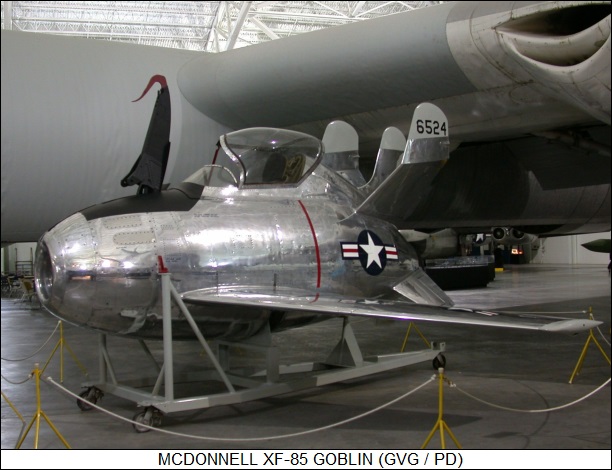
With funding shortfalls, the USAF couldn't afford to tinker with the idea any longer. McDonnell engineers had ideas for more capable Goblin follow-ons, but they just weren't going to happen. Midair refueling was seen as the answer to long-range escort, while changes in operational doctrine and improvements in surface-to-air missiles (SAM) would make the notion of escort less relevant anyway. An escort fighter could do little to deal with a SAM; bombers turned to low-level penetration and ever improving defensive countermeasures systems to reach a target. Both Goblins have survived as museum displays.
BACK_TO_TOP* The Air Force did remain interested in the parasite fighter concept, working on "Fighter Conveyor (FICON)", in which a B-36 was to carry a Republic F-84 Thunderjet fighter nestled under the bomb bay -- the principle not being that the F-84 would provide an escort, but that it would perform a nuclear strike. There were serious concerns about the survivability of the slow B-36 in attacks on the USSR; however, the B-36 could carry the F-84 over intercontinental distances, and then launch it to perform a high-speed run into the target area.
Tests were performed with an RB-36F converted to carry an F-84E, with the modified carrier aircraft being designated the "GRB-36F". Initial FICON trials were in 1952, with the first "all-up" test on 14 May, the F-84E being taken to altitude, released, and then recovered. The scheme seemed satisfactory, the only difficulty being that the F-84E was carried semi-externally, and the drag cut into the bomber's range. A faster swept-wing F-84F Thunderstreak fighter was modified to take over trials from the straight-winged F-84E in May 1953. The Thunderstreak was given a nose trapeze, plus a drooping tailplane to ease fit in the GRB-36F, and assigned the designation of "YRF-84F".
The Air Force decided to commit the concept, though the mission was to be long-range reconnaissance instead of nuclear strike. Ten RB-36D bombers were converted to "GRB-36D" carrier aircraft; 25 RF-84F Thunderflash reconnaissance aircraft were modified with a retractable skyhook and drooping tailplanes, to be redesignated "RF-84K". The RF-84K had four 12.7-millimeter (0.50 caliber) Browning machine guns, and could in principle help defend the carrier platform. It could also still carry a nuclear store.
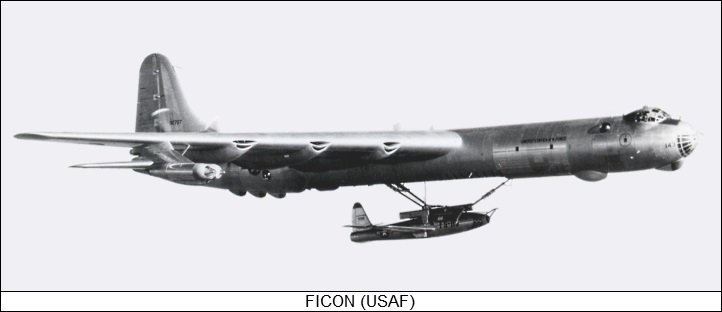
FICON actually went into formal service in the mid-1950s for about a year. Records suggest that it wasn't very practical, particularly with respect to recoveries in bad weather, and it never reached full operational status. In any case, the introduction of the long-range Lockheed U-2 "Angel" reconnaissance aircraft in 1956 eliminated any need for FICON.
* Another scheme, known as "Tip-Tow" or "MX-108A", involved a B-29 modified to allow F-84s to hook up wingtip-to-wingtip using a clamping module on each of the B-29's wingtips. It was a follow-up to a postwar experiment involving a wingtip coupling between a Douglas C-47 Dakota / DC-3 and a Culver PQ-14 -- a light single-seat sport aircraft, used as a target drone during the conflict. Tip-Tow tests were conducted from 1950; they came to an abrupt end on 24 April 1953, when an F-84 flipped over and tore off the wing of the B-29, with all crew killed in the disaster. The problem was that there were vortices around the B-29's wingtips that made the hookups very troublesome.
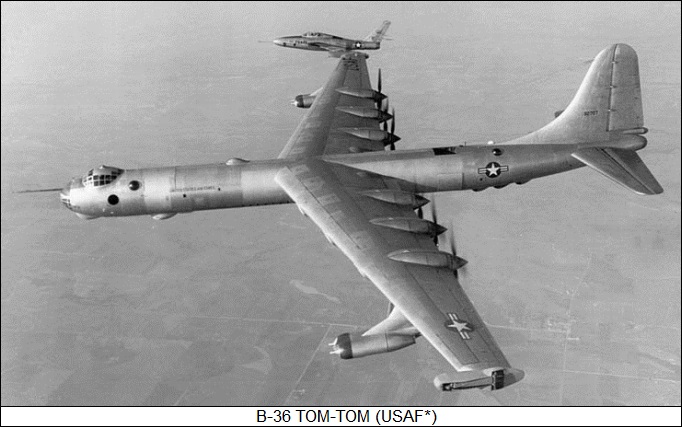
During 1955, the same concept was tested with an RB-36F -- one earlier used for FICON tests -- and two RF-84Fs under the obscure program name of "Tom-Tom". Tom-Tom ran into the same problems as Tip-Tow, with an RF-84F actually torn away from the wingtip of the RB-36F on 23 September 1956. Nobody was hurt, but the scheme was obviously dodgy and dangerous, and so it was promptly abandoned. Incidentally, well-known Air Force test pilot Clarence "Bud" Anderson flew in the FICON, Tip-Tow, and Tom-Tom trials, discussing them later in his memoirs.
* The notion of parasite fighters was very popular in the 1950s, at least until experiments demonstrated its weaknesses. Popular concepts for giant globe-circling nuclear-powered bombers often featured them hauling along a few little fighters for self-defense. Such concepts were more or less science-fiction, but in 1950 and 1951, Douglas Aircraft came up with a series of designs for a long-range strategic bomber, the "Douglas Model 1211", that embraced the parasite fighter concept.
One of the earlier configurations, the "Model 1211J", was a swept-wing machine featuring four large turboprop engines driving contra-rotating props, defensive armament consisting of a tail turret with twin cannon. It had a distinct resemblance to the Soviet Tupolev Tu-95 "Bear" bomber. It could carry heavy external loads under the wings, such as fuel tanks, special equipment pods, Snark standoff cruise missiles, or two Douglas Skyray fighters. For carriage of the fighters, a special rig with trapeze gear would be attached under each wing between the inboard and outboard turboprops.
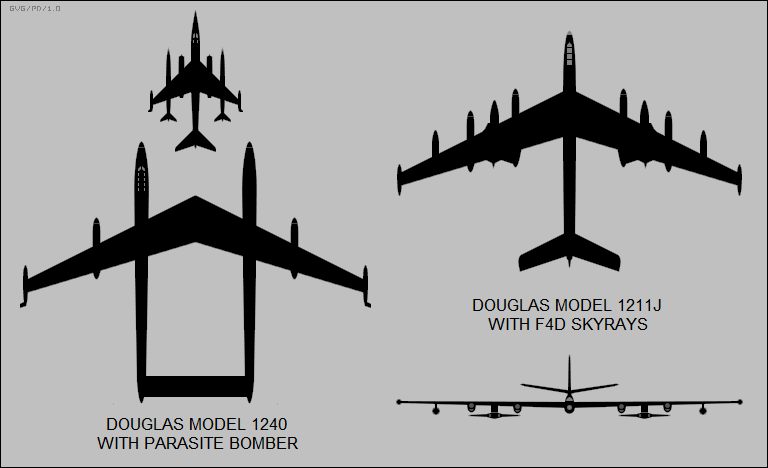
Further Model 1211 concepts involved variations such as booster jets. Douglas also came up with "Model 1240" concepts that involved an aircraft in the same class as the Model 1211 but with twin fuselages, capable of carrying a large non-recoverable parasite aircraft along the lines of a medium bomber on the wing centerline. The concept was along the lines of the modern Rutan "White Knight" suborbital spacecraft carrier, but of course much bigger. Apparently it could carry a standoff missile or parasite fighter under each wing as an alternate payload. The Model 1211 and 1240 concepts were certainly interesting -- but nothing came of them except some very pretty models, the Boeing B-52 being adopted as America's long-range strategic bomber.
BACK_TO_TOP* In the early 1970s, the parasite fighter concept was revived, in the form of a Boeing study investigating the use of a 747 jumbo jet as a flying aircraft carrier. The study was performed under a contract from the US Air Force Flight Dynamics Laboratory (USAF FDL) at Wright-Patterson Air Force Base in Ohio.
The Boeing concept was very ambitious, envisioning a 747-200 class jetliner as an "airborne aircraft carrier (AAC)", with a complement of ten "microfighters". The 747 would not only be able to launch and retrieve the microfighters, but also refuel them in flight or, on retrieval, top them up with fuel and weapons for a new sortie. The 747 would carry enough materiel to support three sorties per microfighter. The study considered the use of the Lockheed C-5A cargolifter as an alternative carrier aircraft -- but not too surprisingly, the Boeing engineers judged the 747 the better choice.
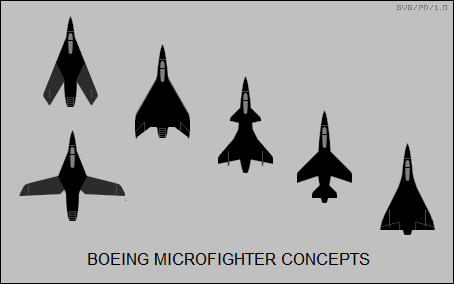
Five different designs were considered for the microfighter, basically using the same fuselage, but with different wing layouts:
The stowed span of the microfighter was limited to 5.36 meters (17 feet 6 inches) to allow fit into the 747, and loaded weight of the aircraft was around 4,760 kilograms (10,500 pounds). For a standard of comparison, an early model F-16 had a loaded weight of 18,140 kilograms (40,000 pounds), while a Northrop F-5A, regarded as a "lightweight fighter", was half that, about 9,070 kilograms (20,000 pounds). The microfighter's weight was comparable to that of a typical modern jet trainer, and in the same ballpark as that of the P-51 Mustang. The microfighters could get away with a lighter weight, at least to an extent, because they didn't require real landing gear and they didn't have to climb to cruise altitude, saving fuel burn.
All the configurations had an engine intake under the belly -- along the lines of the intake of an F-16 -- feeding a single General Electric (GE) YJ101 afterburning bypass jet engine with thrust in the range of 66.7 kN (6,800 kgp / 15,000 lbf). Incidentally, the YJ101 was designed for the Northrop YF-17 lightweight fighter demonstrator, which was the basis for the McDonnell-Douglas F/A-18 Hornet; the Hornet ended up being powered by the GE F404, a modestly improved version of the YJ101. Performance of the microfighters was expected to match that of later model Soviet Mikoyan MiG-21 fighters or comparable Mach 2 opponents.
The microfighters would have a midair refueling boom socket on the back, and like the Goblin had auxiliary skid landing gear for emergency landings. They were to be fitted with a simple multimode radar and have built-in armament of twin Colt M39 20-millimeter revolver-type cannon, with 400 rounds of ammunition per gun. There was a stores attachment under each wing root for a notional smart bomb with a weight of 800 kilograms (1,635 pounds), an alternate stores arrangement being an air-to-air missile (AAM) like the AIM-7 Sparrow on an inboard underwing pylon; of course, other stores arrangements were possible. The stores fit had to be considered in light of the need to ensure safe launch and recovery of an armed microfighter.
The baseline fighter design was leveraged off existing technology, allowing it to be developed quickly, but refinements for a next-generation fighter were examined as well -- such as improved radar; a next-generation engine, with a vectored-thrust exhaust that could pivot in the vertical plane; and carriage of short-range "dogfighting" AAMs, with a form-factor along the lines of a 12.7-centimeter (5-inch) Zuni unguided rocket with vectored-thrust controls, one or two AAMs being stowed in tunnels inside each wing root. The tunnels had covers that would be discarded to permit the missile heat seekers to obtain target lock.
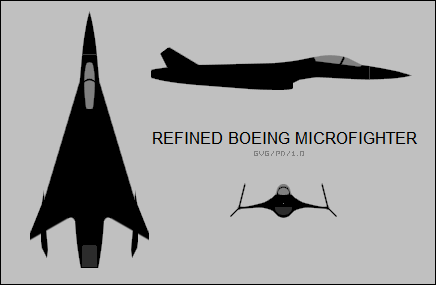
* The 747 carrier aircraft was envisioned as having two decks, including an upper hangar deck where aircraft were stowed; and a lower flight deck where they could be handled for sorties. There were two launch / recovery bays, one fore and one aft of the wing, allowing the carrier aircraft to launch and recover microfighters simultaneously. A microfighter would be extended out a bay belly hatch on a trapeze system. There was an inflight refueling boom associated with each of the two bays, allowing the microfighters to top off and continue a sortie; when a fighter was to be recovered, the refueling boom would make the hookup and draw the aircraft into the trapeze. Once the belly hatch was closed, the flight deck bay would be repressurized, allowing service crews to prep the aircraft for another sortie. Munitions would be hauled to the aircraft on rail-mounted trolleys. Turnaround time between sorties was estimated at about ten minutes.
The 747 carrier aircraft would have a crew of 42 -- including the 747 aircrew, microfighter aircrew, and service crew. Along with use as a microfighter carrier, the 747 could be used as a tanker for other aircraft, and was to be convertible to a degree to the cargolift mission. A complementary "Airborne Warning & Control System (AWACS)" 747 was considered, featuring a radar radome and communications links; the AWACS 747 would also carry two microfighters configured for reconnaissance missions, with the reconnaissance film processed on board the carrier aircraft.
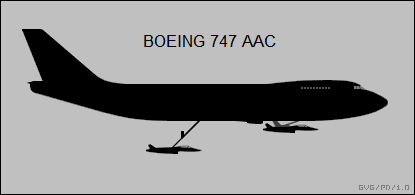
* Of course, the 747 AAC never came close to happening. It appears that the rationale behind the scheme was as a system to deliver an air combat element to a remote war zone on short notice, or to project force in regions where land or sea basing wasn't possible -- interestingly, the study claimed that the 747 ACC was cheaper than setting up a land base in a forward area, at least for a short-term mission. Obviously, the need for such a system was not seen as serious enough to justify the cost of development; no doubt the limited capability of the microfighters also suggested they were "kiddie cars", though they certainly looked like they would have been enormous fun to fly, "zippy little rocket ships".
The 747 AAC was sexy, and it is interesting to consider use of the later 747-300 model with its extended first-class cabin in the role, providing more comfortable accommodations and facilities for the crew. The sexiness appears to have been the entire rationale of the investigation, just to see if such a fun idea had enough merit to be worth funding. The answer was clearly NO.
The concept has been revived, at least in an altered and updated form, by the US Defense Advanced Research Projects Agency (DARPA), the Pentagon's "blue sky" investigation office, under the "Gremlin" program -- which envisions launching drones for reconnaissance and electronic warfare missions from a larger carrier aircraft, and then recovering them again after they've completed their mission. Obviously, the carrier aircraft could also launch small cruise missiles.
As with the Boeing microfighters, adding landing gear to a drone adds to weight and complexity; it would be much simpler, at least from the mechanical point of view, to simply snatch them out of the air. An air-mobile launch and recovery platform would also make it easy to deploy drones over a battle area, and give them more reach. DARPA was, at last notice, performing trials with Dynetics / Kratos X-61A drones and a C-130 -- with the use of the C-130 adding to the "Herky's" already impressive list of mission capabilities, from transport, to tanker, to electronic warfare, to gunship. However, DARPA only does investigations; the armed services will have to pick up the project to make it a reality.
BACK_TO_TOP* I had been thinking of writing a document on the parasite fighters for years before I got around to doing it, hesitating because I didn't think there was enough there to support a full writeup. When I finally jumped in, the end result was much more detailed than I had expected, and I keep finding little bits and pieces of information to extend it.

* Sources include:
* Revision history:
v1.0.0 / 01 nov 09 v1.0.1 / 01 dec 09 / Minor fixes. v1.0.2 / 01 aug 11 / Added Douglas 1211J & 1240. v1.0.3 / 01 jul 13 / Review & polish. v1.0.4 / 01 jul 14 / Review & polish. v1.0.5 / 01 jun 16 / Review & polish. v1.0.6 / 01 may 18 / Review & polish. v1.0.7 / 01 mar 20 / X-61A drone. v1.0.8 / 01 jan 22 / Review & polish. v1.0.9 / 01 dec 23 / Review & polish.BACK_TO_TOP
